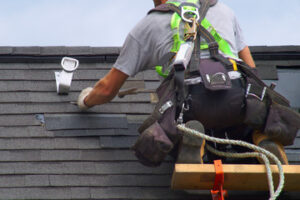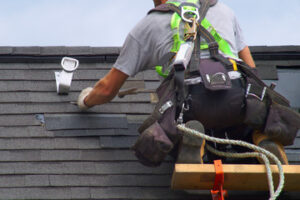Heavy rain, ice, and snow can cause damage to shingles and sheathing. Damage from this type of extreme weather can be covered by insurance.

Leaks are easier to spot on flat roofs by looking for pools of water or stains along walls. Inspecting your roof regularly can hasten the need for repairs and filing an insurance claim.
Gutters are designed to channel water off your roof and away from the foundation, but they can’t do that if they’re clogged with leaves, twigs, and other debris. The resulting overflow can damage your siding, roof, and foundation. It can also cause rotting and mold growth, which poses health risks for your family and degrades the functionality of your roof. Regular gutter cleaning and inspections prevent these issues from occurring.
While you’re cleaning your gutters, look for signs of wear and tear that might indicate a problem. This includes cracks and chips on the gutter surface; signs of rust around gutter connections; and deterioration of the material. Check for clogs as well, particularly around downspouts and in corners of the gutter system.
If you notice any of these problems, it’s a good idea to hire a professional for roof maintenance. They’ll be able to repair the damage before it causes major problems and save you money in the long run.
During a roof inspection, the technician will examine the condition of your gutters as well. They’ll make sure that the gutters slope downward to direct water properly, and that the downspouts are free of blockages. They’ll also inspect the gutters and downspouts for rust, corrosion, and looseness.
If the gutter system isn’t properly pitched, it can overflow when it rains, causing water to seep into concealed cornice and roof areas. It can also lead to foundation issues and other serious structural problems.
If you’re going to clean your gutters yourself, be sure to use common sense safety precautions when using a ladder. Make sure to have a spotter if you’re not comfortable climbing on the roof, and always maintain three-point contact with the ladder. You should also be sure to use a ladder with locking rungs for added stability. It’s also a good idea to use a gutter scoop, which will help remove larger pieces of debris without damaging the shingles. Be sure to wear gloves and a protective face mask when scooping up debris. Once you’ve removed the larger debris, place it in a bucket or on a tarp and flush it out with a hose to get rid of the smaller particles.
Clean the Attic
Your roof is your home’s primary defense against the elements, and it must be kept clean to prevent minor problems from escalating into more serious issues. A properly maintained roof is an investment in your family’s safety and security, and it can improve your home’s value and curb appeal. Performing routine cleaning and inspections can extend the life of your roof, preventing premature replacement and lowering energy costs.
While most homeowners think of cleaning their gutters as a part of roof maintenance, the attic is another critical area to clean regularly. Often overlooked, the attic is a breeding ground for dust and dirt that can circulate through air ducts throughout the house and cause respiratory problems and allergies. It can also become a haven for rodents and other pests that spread diseases, including the potentially deadly hantavirus. Attic cleaning and decontamination prevents these health problems and helps maintain a safe and healthy living environment for your family.
During an attic cleaning and decontamination service, the professional cleaners remove all debris and junk from the attic space. They also assess the health and adequacy of insulation, if any exists. If it is old and contaminated, they will replace it with new insulation. They will also address any rodent infestation by identifying, removing, and decontaminating rodent droppings, urine, and nesting materials. Finally, they will proof the attic to ensure that future rodents cannot enter the home through the attic.
A thorough attic cleaning and inspection includes looking for signs of water damage to shingles and interior walls. They will look for discoloration, water spots on the ceilings and walls, moss, mildew, musty odors, and other indicators of a leaky roof. In addition, the roofers will check exterior ridge vents, soffit vents, and gable vents to make sure that they are clear of any obstructions.
A professional attic cleaning and inspection can catch many issues in their early stages, such as a small leak that could eventually lead to extensive mold damage and shingle replacement. The attic inspection can also help identify other issues that might be affecting the structure of the roof, such as a lack of ventilation and poor insulation.
Inspect the Roof
One of the best things you can do for your roof is to hire a professional to perform a thorough inspection. An inspector will look at everything from the structure of your roof to its flashing and even its insulation. This will help identify problems like leaks and missing shingles before they become major issues that require extensive repairs or even replacement.
A thorough inspection will also help you to keep track of your roof maintenance and repair schedules. A roofing professional can help you create a regular schedule to ensure that your roof is in top condition. The National Roofing Contractors Association recommends having your roof inspected at least twice per year.
Your inspector will look for signs of structural problems, such as a sagging roof that may indicate foundational or structural issues. They will also look at the condition of shingle surfaces and check for loose or missing ones, as well as examine the condition of caulk lines and sealants. In addition, they will look for proper venting and ensure that the roof penetrations, such as skylights and chimneys are well-sealed and in good condition.
A qualified roofing inspector will also examine the attic and crawl space for signs of moisture, mold, and insulation issues. They will also inspect the gutters and downspouts for clogs, leaks, or damage. They will also take note of any previous repairs and double-check that they were done properly.
If you have a flat roof, your inspector will look for any signs of pooling water, blisters or punctures. They will also look at the slope of the roof to make sure it is at an appropriate pitch for your area. They will also check for structural issues, such as sagging or uneven roof planes.
Another important aspect of a roof inspection is to examine the roof’s flashing, which is where the majority of leaks occur. Inspectors will look for gaps between too-large shingles, improper nailing, or other workmanship issues that could lead to leaks. They will also examine the flashing around chimneys, vents, and other roof projections to ensure that they are properly sealed.
Inspect the Interior
During roof maintenance, roofing professionals also check the interior of a home to detect signs of moisture or mold. They also examine attic insulation and ventilation to ensure they are functioning correctly. Documenting these findings helps a homeowner understand and evaluate the current condition of their roof and home, provides valuable information for insurance claim reviews and substantiates any future claims against property damage caused by the roof.
Extreme weather, a common occurrence in Minneapolis and many other regions, takes its toll on the structural integrity of a residential roof. Strong winds, heavy snowfall, and hail storms can uplift shingles and create openings for water infiltration. Regular inspections allow a professional to identify and address any storm-related damage before it becomes more severe.
The extreme temperature fluctuations that Minneapolis experiences throughout the year can also impact the lifespan of a roof. Moisture trapped in attic spaces and gaps in the insulation can cause a shingle to blister. It can also lead to a weakening of the materials used in the roof, such as wood framing and drywall. Having a well-functioning and properly installed roof that is inspected regularly will help extend the life of the roofing material.
Moisture accumulation can also lead to the growth of mildew and mold, which in turn can deteriorate insulation and damage wood framing and structural steel. Performing routine maintenance and inspections will enable a homeowner to catch and address issues before they become more serious, saving them thousands in repair costs.
In addition, a properly installed and maintained roof contributes to effective attic insulation and energy efficiency. Routine maintenance can also help reduce the strain on heating and cooling systems, which in turn saves money on utility bills.

